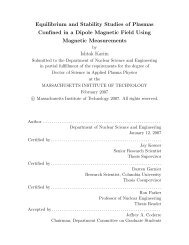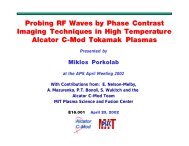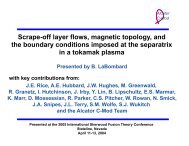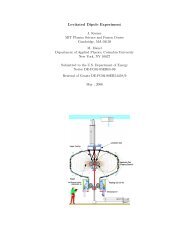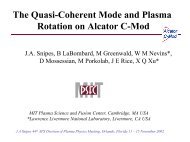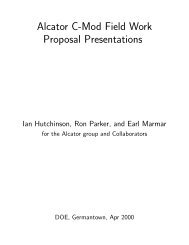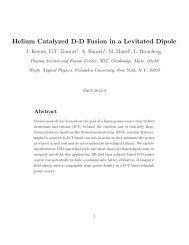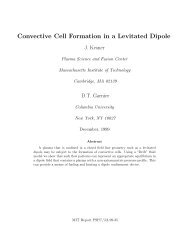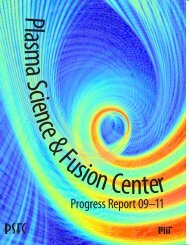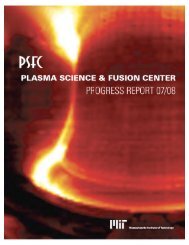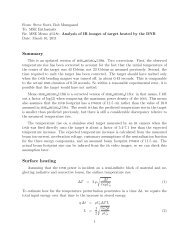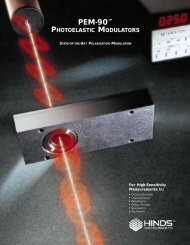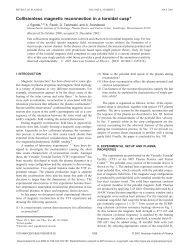Detailed analysis of MSE spectra
Detailed analysis of MSE spectra
Detailed analysis of MSE spectra
You also want an ePaper? Increase the reach of your titles
YUMPU automatically turns print PDFs into web optimized ePapers that Google loves.
From: Steve Scott<br />
To: Howard Yuh, Bob Granetz<br />
Re: <strong>MSE</strong> Memo #8: <strong>Detailed</strong> Analysis <strong>of</strong> <strong>MSE</strong> FFT Spectra<br />
Date: July 2, 2003<br />
Motivation<br />
Previous memos in this series have carried out standard Müeller Matrix <strong>analysis</strong> for the mse<br />
diagnostic optics including the effect <strong>of</strong> imperfect mirrors which introduce a phase shift δ and<br />
a non-unity reflectivity ratio r m for the S- versus P- polarizations. The calculated photon<br />
intensity at the photomultiplier tubes is:<br />
[<br />
4I net = (I b + I 0 ) 1 + r m + r ]<br />
m − 1<br />
√ (cos(A) + sin(A) sin(B))<br />
2<br />
[<br />
+I 0 cos(2γ) r m − 1 + r ]<br />
m + 1<br />
√ (cos(A) + sin(A) sin(B))<br />
2<br />
+I 0 sin(2γ) √ 2r m [cos(δ) cos(B) + sin(δ)(sin(A) − sin(B) cos(A))] (1)<br />
where the time-dependent retardances imposed by the two pem’s are A(t) = R 1 cos(ω 1 t)<br />
and B(t) = R 2 cos(ω 2 t). Customarily, we operate both pem’s with a retardance amplitude<br />
R 1 = R 2 = π.<br />
I wrote a small idl procedure to calculate I net (t) directly from Eq. 1 given user-supplied<br />
values for the mirror properties, the pem retardances, the pitch-angle <strong>of</strong> the magnetic field in<br />
the coordinate frame <strong>of</strong> the mse diagnostic. Then I performed standard fft decomposition<br />
to determine the expected fft amplitudes for various assumptions about the diagnostic<br />
performance. This provides a check on analytic calculations <strong>of</strong> the fft amplitudes, which<br />
are obtained using the expansions:<br />
cos(R cos(ωt)) =<br />
∞∑<br />
J 0 (R) + (−1) n J 2n (R) cos(2nωt)<br />
n=1<br />
sin(R cos(ωt)) =<br />
∞∑<br />
2 (−1) n−1 J 2n−1 (R) cos((2n − 1)ωt). (2)<br />
n=1<br />
Note that the terms sin(A(t)) sin(B(t)) and sin(B(t)) cos(A(t)) in Eq. 1 will give rise to a<br />
large number <strong>of</strong> fft components at frequencies corresponding to sums and differences <strong>of</strong> ω 1<br />
and ω 2 .<br />
It’s convenient to group the terms into two sets: ‘ideal’ frequencies at which we expect<br />
nonzero fft amplitudes for mirrors having no phase shift (δ = 0), and additional ‘nonideal’<br />
terms that arise when the mirrors introduce a phase shift. These frequencies are listed in<br />
Table 1. Since ω 1 ≈ ω 2 , the ideal frequencies tend to be grouped around the even multiplies<br />
<strong>of</strong> the pem frequencies, while the nonideal frequencies tend to be groupe around the odd<br />
multiples. As we will see in subsequent plots, the expected fft spectrum is quite rich, with<br />
significant fft amplitudes out to at least 4 times the fundamental pem frequency, and with<br />
4-5 split components near each harmonic.<br />
1
Ideal Nonideal<br />
0 ω 1<br />
2ω 1 3ω 1<br />
4ω 1 5ω 1<br />
6ω 1 7ω 1<br />
8ω 1 9ω 1<br />
2ω 2 ω 2<br />
4ω 2 3ω 2<br />
6ω 2 5ω 2<br />
8ω 2 7ω 2<br />
ω 1 ± ω 2 9ω 2<br />
3ω 1 ± ω 2 2ω 1 ± ω 2<br />
5ω 1 ± ω 2 4ω 1 ± ω 2<br />
7ω 1 ± ω 2 6ω 1 ± ω 2<br />
3ω 2 ± ω 1 8ω 1 ± ω 2<br />
5ω 2 ± ω 1 3ω 2 ± 2ω 1<br />
7ω 2 ± ω 1 4ω 1 ± 3ω 2<br />
3ω 1 ± 3ω 2 5ω 2 ± 2ω 1<br />
5ω 1 ± 3ω 2 6ω 1 ± 3ω 2<br />
5ω 2 ± 3ω 1 5ω 2 ± 4ω 1<br />
5ω 1 ± 5ω 2 7ω 2 ± 2ω 1<br />
7ω 1 ± 3ω 2<br />
7ω 2 ± 3ω 1<br />
9ω 1 ± 1ω 2<br />
9ω 2 ± 1ω 1<br />
Table 1: Frequencies at which we expect nonzero fft amplitudes for ideal and nonideal<br />
mirrors. Nonideal mirrors will have the frequency components listed in both columns.<br />
Expected Signals When only One PEM is Operating<br />
If we turn <strong>of</strong>f pem#2, then<br />
I net = M p · M P EM1 · M m · S v . (3)<br />
Doing the matrix multiplication with Maple yields an intensity<br />
4I net = (I 0 + I b )(1 + r m + r m − 1<br />
√ cos(A) 2<br />
+I 0 cos(2γ)(r m − 1 + r m + 1<br />
√ cos(A)) 2<br />
+I 0 sin(2γ) √ 2r m (cos(δ) + sin(δ) sin(A)). (4)<br />
Making the usual substitutions yields the intensities:<br />
I ω1 = I 0 sin(δ) √ r m J 1 (A 1 )<br />
√<br />
2<br />
sin(2γ)<br />
2
Figure 1: Computed fft spectrum for mse operating with both pems at their customary<br />
retardance (R 1 = R 2 = π) for imperfect mirrors having a large phase shift, δ = 30 o . A<br />
field-line pitch angle <strong>of</strong> 24 o with respect to the pem optics is assumed. The light green<br />
lines represent frequencies that are expected from ideal mirrors. The yellow lines reprsent<br />
frequencies that are expected from the non-ideal mirror behavior. The important point <strong>of</strong><br />
this figure is that non-negligible fft amplitudes occur only at those frequencies where we<br />
expect them - all <strong>of</strong> the fft features correspond to either a known ideal or a known non-ideal<br />
frequency.<br />
3
Figure 2: Computed fft spectrum for mse operating with both pems at their customary<br />
retardance (R 1 = R 2 = π) for perfect mirrors having no shift, δ = 0 o and equal reflectivity<br />
for S- and P- polarization. A field-line pitch angle <strong>of</strong> 24 o with respect to the pem<br />
optics is assumed. Magenta vertical lines indicate the frequencies corresponding to simple<br />
harmonics <strong>of</strong> the pem frequencies. The blue lines represent the fft amplitudes that are<br />
close to frequencies expected for ideal mirrors listed in Table 1. In subsequent plots, green<br />
lines represent fft amplitudes that are near frequencies expected from the non-ideal mirror<br />
characteristics.<br />
4
Figure 3: fft spectrum for mse operating with both pems at their customary retardance<br />
(R 1 = R 2 = π) for perfect mirrors having no shift, δ = 0 o and equal reflectivity for S- and<br />
P- polarization. A field-line pitch angle <strong>of</strong> 24 o with respect to the pem optics is assumed.<br />
This is the same case as the previous plot, Fig. 2, but plotted on a log scale to allow the<br />
identification <strong>of</strong> low-amplitude components.<br />
5
Figure 4: fft spectrum for mse operating with both pems at their customary retardance<br />
(R 1 = R 2 = π) for imperfect perfect mirrors having a moderate phase shift, δ = 5 o and<br />
unity reflectivity for S- and P- polarization. A field-line pitch angle <strong>of</strong> 24 o with respect to<br />
the pem optics is assumed. Note that the mirror’s phase shift creates new but rather small<br />
fft amplitudes near the first and third harmonics <strong>of</strong> both pem frequencies.<br />
6
Figure 5: fft spectrum for mse operating with both pems at their customary retardance<br />
(R 1 = R 2 = π) for imperfect perfect mirrors having a moderate phase shift, δ = 5 o and<br />
unity reflectivity for S- and P- polarization. A field-line pitch angle <strong>of</strong> 24 o with respect to<br />
the pem optics is assumed. Note that the mirror’s phase shift creates new but rather small<br />
fft amplitudes near the first and third harmonics <strong>of</strong> both pem frequencies. This is the same<br />
case as the previous plot, Fig. 4, but plotted on a log scale to allow the identification <strong>of</strong><br />
low-amplitude components.<br />
7
Figure 6: fft spectrum for mse operating with both pems at their customary retardance<br />
(R 1 = R 2 = π) for imperfect perfect mirrors having a large phase shift, δ = 30 o and unity<br />
reflectivity for S- and P- polarization. A field-line pitch angle <strong>of</strong> 24 o with respect to the<br />
pem optics is assumed. Note that the mirror’s phase shift creates new but rather small fft<br />
amplitudes near the first and third harmonics <strong>of</strong> both pem frequencies.<br />
8
Figure 7: fft spectrum for mse operating with both pems at their customary retardance<br />
(R 1 = R 2 = π) for imperfect perfect mirrors having a large phase shift, δ = 30 o and unity<br />
reflectivity for S- and P- polarization. A field-line pitch angle <strong>of</strong> 24 o with respect to the<br />
pem optics is assumed. Note that the mirror’s phase shift creates new but rather small fft<br />
amplitudes near the first and third harmonics <strong>of</strong> both pem frequencies. This is the same<br />
case as the previous plot, Fig. 6, but plotted on a log scale to allow the identification <strong>of</strong><br />
low-amplitude components.<br />
9
Figure 8: fft spectrum for mse operating with both pems at their customary retardance<br />
(R 1 = R 2 = π) for imperfect perfect mirrors having a very large phase shift, δ = 60 o and<br />
unity reflectivity for S- and P- polarization. A field-line pitch angle <strong>of</strong> 24 o with respect to<br />
the pem optics is assumed. Note that the mirror’s phase shift creates new but rather small<br />
fft amplitudes near the first and third harmonics <strong>of</strong> both pem frequencies.<br />
10
Figure 9: fft spectrum for mse operating with both pems at their customary retardance<br />
(R 1 = R 2 = π) for imperfect perfect mirrors having a very large phase shift, δ = 60 o and<br />
unity reflectivity for S- and P- polarization. A field-line pitch angle <strong>of</strong> 24 o with respect to<br />
the pem optics is assumed. Note that the mirror’s phase shift creates new but rather small<br />
fft amplitudes near the first and third harmonics <strong>of</strong> both pem frequencies. This is the same<br />
case as the previous plot, Fig. 8, but plotted on a log scale to allow the identification <strong>of</strong><br />
low-amplitude components.<br />
11
Figure 10: Computed ratio <strong>of</strong> fft amplitude at 20 kHz to 40 kHz as a function <strong>of</strong> the<br />
assumed phase shift, δ, introduced by the mse mirrors. For these calculations both pems<br />
are assumed to be operating at their nominal retardance, R 1 = R 2 = π and the mirrors are<br />
assumed to have the same reflectivity for S- and P- polarizations.<br />
12
Figure 11: Computed ratio <strong>of</strong> fft amplitude at 20 kHz to 40 kHz as a function <strong>of</strong> the<br />
assumed phase shift, δ, introduced by the mse mirrors. For these calculations both pems<br />
are assumed to be operating at their nominal retardance, R 1 = R 2 = π and the mirrors are<br />
assumed to have the same reflectivity for S- and P- polarizations. This is the same data as<br />
shown in Fig. 10 but the x-axis has been expanded.<br />
13
Figure 12: fft spectrum for mse operating with both pems at their customary retardance<br />
(R 1 = R 2 = π) for imperfect perfect mirrors having a large phase shift, δ = 30 o and in<br />
addition a reflectivity ratio R m = 0.6 and a ratio <strong>of</strong> unpolarized-to-polarized light <strong>of</strong> 10:1.<br />
A field-line pitch angle <strong>of</strong> 24 o with respect to the pem optics is assumed. The point <strong>of</strong> this<br />
plot is whether we can possibly generate the fft amplitudes that we observe at the first<br />
harmonic by even unreasonable assumptions about non-ideal features <strong>of</strong> the mirrors.<br />
14
Figure 13: fft spectrum for mse operating with both pems at their customary retardance<br />
(R 1 = R 2 = π) for imperfect perfect mirrors having a large phase shift, δ = 30 o and in<br />
addition a reflectivity ratio R m = 0.6 and a ratio <strong>of</strong> unpolarized-to-polarized light <strong>of</strong> 10:1.<br />
A field-line pitch angle <strong>of</strong> 24 o with respect to the pem optics is assumed. The point <strong>of</strong> this<br />
plot is whether we can possibly generate the fft amplitudes that we observe at the first<br />
harmonic by even unreasonable assumptions about non-ideal features <strong>of</strong> the mirrors. This<br />
is the same plot as Fig. 12<br />
15
Figure 14: Bessel functions J 0 , J 1 , and J 2 . The nominal retardance <strong>of</strong> the pems is R = π.<br />
There is a zero <strong>of</strong> J 0 at 2.405 and a zero <strong>of</strong> J 1 at 3.832 so if the actual retardance <strong>of</strong> one or<br />
both pems deviates from the nominal value by about 0.7 we would see unusual ratios <strong>of</strong> the<br />
22 kHz to 20 kHz.<br />
16
δ (degrees) I 40 /I 20 I 22 /I 20<br />
5 26.8 0.72<br />
30 4.6 0.72<br />
60 2.6 0.72<br />
R <strong>MSE</strong> (cm)<br />
86.8 3.5 0.029<br />
85.3 4.4 0.023<br />
83.7 3.9 0.024<br />
82.1 4.4 0.036<br />
78.5 4.4 0.018<br />
76.6 5.0 0.059<br />
74.6 5.9 0.086<br />
72.5 7.5 0.15<br />
70.9 7.5 0.21<br />
67.1 2.7 0.16<br />
Table 2: Comparison <strong>of</strong> expected intensity ratios (for different assumptions about the phase<br />
shift imposed by the mirror) to the observed intensity ratio on calibration shot 1030521013.<br />
Note that the intensity ratio I 40 /I 20 is matched only if we assume a very large phase shift<br />
<strong>of</strong> order 30 o , whereas from the mirror specs we expect a phase shift <strong>of</strong> less than a degree<br />
or so. However, we observe very little intensity at 22 kHz, e.g. in the outer channels the<br />
observed intensity in the 20 kHz component is 25-50 times larger than the 22 kHz component,<br />
whereas we expect them to have roughly the same intensity if the pem retardances are at<br />
their nominal values, R 1 = R 2 = π. So imperfect mirrors that impose a large phase shift <strong>of</strong><br />
order 30 o would be consistent with our data only if the retardance is also <strong>of</strong>f.<br />
I ω2 = 0.<br />
I 2ω1 = (I b + I 0 )J 2 (A 1 )(1 − r m )<br />
2 √ − I 0J 2 (A 1 )(1 + r m )<br />
2<br />
2 √ cos(2γ)<br />
2<br />
I 2ω2 = 0. (5)<br />
Note that the intensities for ω 1 and 2ω 1 are just the same as when both pem#1 and pem#2<br />
are operating. Also note that there will be a nonzero intensity at frequency ω 1 only if the<br />
mirrors introduce a phase shift, i.e. if mirrors were perfect (δ = 0), there would be no<br />
intensity at ω 1 .<br />
Similarly, we we turn <strong>of</strong>f pem#1, then<br />
which yields<br />
I net = M p · M P EM2 · M m · S v . (6)<br />
4I net = (I 0 + I b )(1.707r m + 0.2929)<br />
+I 0 cos(2γ)(1.707r m − 0.2929)<br />
+I 0 sin(2γ)(cos(δ) cos(B) − sin(δ) sin(B)). (7)<br />
17
This yields intensities:<br />
I ω1 = 0.<br />
I ω2 = − I 0<br />
I 2ω1 = 0.<br />
I 2ω2 = − I 0<br />
√<br />
rm sin(δ)J 1 (A 2 )<br />
√<br />
2<br />
sin(2γ)<br />
√<br />
rm cos(δ)J 2 (A 2 )<br />
√<br />
2<br />
sin(2δ) (8)<br />
The fft amplitude <strong>of</strong> 2ω 2 is the same as for the case when both pems are operating. The<br />
fft amplitude <strong>of</strong> ω 2 has the same parametric dependence as when both pems are operating,<br />
except that it has been reduced in magnitude by a factor J 0 (A 1 ). The lack <strong>of</strong> symmetry is<br />
troubling.<br />
18
Figure 15: fft spectrum for mse operating with only pem-1 at its customary retardance<br />
(R 1 = π) for perfect mirrors having no phase shift, δ = 0 o . A field-line pitch angle <strong>of</strong> 24 o<br />
with respect to the pem optics is assumed. As expected, we lose the fft components that<br />
involve 2ω 2 .<br />
19
Figure 17: fft spectrum for mse operating with only pem-1 at a nonstandard retardance<br />
(R 1 = 1.1π) for perfect mirrors having no phase shift, δ = 0 o . A field-line pitch angle <strong>of</strong> 24 o<br />
with respect to the pem optics is assumed.<br />
21
Figure 18: fft spectrum for mse operating with only pem-1 at a nonstandard retardance<br />
(R 1 = 1.3π) for perfect mirrors having no phase shift, δ = 0 o . A field-line pitch angle <strong>of</strong> 24 o<br />
with respect to the pem optics is assumed.<br />
22
Figure 19: fft spectrum for mse operating with only pem-1 at a nonstandard retardance<br />
(R 1 = 2π) for perfect mirrors having no phase shift, δ = 0 o . A field-line pitch angle <strong>of</strong> 24 o<br />
with respect to the pem optics is assumed.<br />
23
Figure 20: fft spectrum for mse operating with only pem-2 at a standard retardance<br />
(R 2 = π) for an imperfect mirror having a large phase shift, δ = 30 o . A field-line pitch angle<br />
<strong>of</strong> 24 o with respect to the pem optics is assumed.<br />
24
Figure 21: fft spectrum for mse operating with both pems with the second pem operating<br />
at a standard retardance (R 2 = π) but the first pem operating at a retardance that sits at<br />
the zero <strong>of</strong> the zero-th order Bessel function, R 1 = 2.405 for an imperfect mirror having a<br />
large phase shift, δ = 30 o . A field-line pitch angle <strong>of</strong> 24 o with respect to the pem optics<br />
is assumed. As predicted by the <strong>MSE</strong> Memo #7, the choice <strong>of</strong> this retardance for pem#1<br />
removes the fft amplitude at ω 2 .<br />
25
Memo #7 computed the effect <strong>of</strong> imperfect <strong>MSE</strong> mirrors, i.e. mirrors having a different<br />
reflectance for S- and P- polarizations and/or mirrors which introduce a phase shift, on the<br />
<strong>MSE</strong> analyis. We concluded that one signature <strong>of</strong> imperfect mirrors would be to generate<br />
fft components at the pem fundamental frequencies in addition to the usual components<br />
at the second harmonic <strong>of</strong> the pem frequencies:<br />
I ω1 = J 1(A 1 )I<br />
√ 0<br />
Z sin(2γ) (9)<br />
2<br />
(10)<br />
I ω2 = − J 1(A 2 )J 0 (A 1 )I<br />
√ 0<br />
Z sin(2γ) (11)<br />
2<br />
I 2ω1 = − J 2(A 1 )I<br />
√ 0<br />
(S cos(2γ) + T (1 + I b /I 0 )) (12)<br />
2<br />
I 2ω2 = − J 2(A 2 )I<br />
√ 0<br />
Y sin(2γ). (13)<br />
2<br />
where Z is a parameter that arises from the phase shift (i.e. Z = 0 if there is no phase shift)<br />
and T is a parameter that arises from the non-ideal reflectance (i.e. T = 0 if the reflectance<br />
is the same for both S- and P- polarizations). One ‘signature’ <strong>of</strong> non-ideal mirrors would<br />
then be a particular ratio <strong>of</strong> the fft amplitudes at the first harmonic pem frequencies:<br />
I ω2<br />
= − J 0(A 1 )J 1 (A 2 )<br />
I ω1 J 1 (A 1 )<br />
(14)<br />
We believe that both pems are configured to impose a retardance <strong>of</strong> π/2, so A 1 = A 2 = π/2.<br />
Then J 0 (π/2) = 0.472 and J 1 (A 2 ) = 0.567 and J 1 (A 1 ) = 0.567 so the ratio becomes<br />
I ω2<br />
I ω1<br />
= −0.47. (15)<br />
The problem is that, empirically, we observe this ratio to be essentially zero.<br />
One possible explanation for this observation would be if the actual retardance for PEM#1<br />
were to be close to zero <strong>of</strong> J 0 , which occurs for A 1 = 2.405.<br />
This memo works through the arithmetic for a simpler problem, namely a single mirror<br />
which has unity reflectance for the S- polarization, a reflectance r m for the P-polarization,<br />
and which introduces a phase shift δ. The advantage <strong>of</strong> this <strong>analysis</strong> is that we can compare<br />
it to published <strong>analysis</strong> by Nick Hawkes, who solved the same problem, which provides a<br />
check on the answer.<br />
Following Hawkes(JET-R(96)10), we analyze <strong>MSE</strong> optical elements using Müeller matrices<br />
to represent the effects <strong>of</strong> the mirrors, the PEMs, and the fixed polarizer. The Stokes<br />
vector for the output light, I net , is obtained by multiplying together the Müeller matrices for<br />
each element in their order along the optical path,<br />
I net = M p · M P EM2 · M P EM1 · M m · S v (16)<br />
26
Figure 22: Calculated time dependence <strong>of</strong> intensity <strong>of</strong> light passing through the mse diagnostic<br />
optics including pems assuming that only pem-1 is operating. A pitch-angle <strong>of</strong> 24 o<br />
is assumed, and perfect optics are assumed (δ = 0, R m = 1.0). The time dependence is<br />
illustrated for various assumptions <strong>of</strong> the maximum retardation imposed by pem-1 from 0<br />
to π radians. The nominal retardation value is π.<br />
27
Figure 23: Calculated time dependence <strong>of</strong> intensity <strong>of</strong> light passing through the mse diagnostic<br />
optics including pems assuming that only pem-1 is operating. A pitch-angle <strong>of</strong> 24 o<br />
is assumed, and perfect optics are assumed (δ = 0, R m = 1.0). The time dependence is<br />
illustrated for various assumptions <strong>of</strong> the maximum retardation imposed by pem-1 from π<br />
to 2π radians. The nominal retardation value is π.<br />
28
Figure 24: Calculated time dependence <strong>of</strong> intensity <strong>of</strong> light passing through the mse diagnostic<br />
optics including pems assuming that only pem-2 is operating. A pitch-angle <strong>of</strong> 24 o<br />
is assumed, and perfect optics are assumed (δ = 0, R m = 1.0). The time dependence is<br />
illustrated for various assumptions <strong>of</strong> the maximum retardation imposed by pem-1 from 0<br />
to π radians. The nominal retardation value is π.<br />
29
Figure 25: Calculated time dependence <strong>of</strong> intensity <strong>of</strong> light passing through the mse diagnostic<br />
optics including pems assuming that only pem-2 is operating. A pitch-angle <strong>of</strong> 24 o<br />
is assumed, and perfect optics are assumed (δ = 0, R m = 1.0). The time dependence is<br />
illustrated for various assumptions <strong>of</strong> the maximum retardation imposed by pem-1 from π<br />
to 2π radians. The nominal retardation value is π.<br />
30
Figure 26: Calculated ratio <strong>of</strong> fft amplitude at 4ω 1 to the amplitude at 2ω 1 as a function<br />
<strong>of</strong> retardance <strong>of</strong> the pem-1 for a situation where the mse diagnostic is operated with only<br />
pem-1 active. The calculated ratio is independent <strong>of</strong> the phase shift imposed by the mirrors,<br />
δ, and also independent <strong>of</strong> the pitch-angle <strong>of</strong> the field line.<br />
31
Figure 27: Computed ratio <strong>of</strong> signal intensity variation over time, (I max − I min )/(I max +<br />
I min ), as a function <strong>of</strong> pem-1 retardance when the mse diagnostic is operated with only<br />
pem-1 operational. The dependence for various field-line pitch-angles is illustated. These<br />
calculations assume that the mirrors impose zero phase shift, δ = 0, and that the ratio <strong>of</strong> S-<br />
to P- reflectivity is unity.<br />
32
Figure 28: Computed ratio <strong>of</strong> signal intensity variation over time, (I max − I min )/(I max +<br />
I min ), as a function <strong>of</strong> pem-2 retardance when the mse diagnostic is operated with only<br />
pem-2 operational. The dependence for various field-line pitch-angles is illustated. These<br />
calculations assume that the mirrors impose zero phase shift, δ = 0, and that the ratio <strong>of</strong> S-<br />
to P- reflectivity is unity.<br />
33
Figure 29: Computed ratio <strong>of</strong> signal intensity variation over time, (I max −I min )/(I max +I min ),<br />
as a function <strong>of</strong> pem-1 retardance when the mse diagnostic is operated with only pem-1<br />
operational. The dependence for various phase shifts imposed by the mirror (δ) is illustrated<br />
for a field-line pitch-angle <strong>of</strong> 24 o . . These calculations assume that the ratio <strong>of</strong> S- to P-<br />
reflectivity is unity.<br />
34
Figure 30: Computed ratio <strong>of</strong> signal intensity variation over time, (I max −I min )/(I max +I min ),<br />
as a function <strong>of</strong> pem-s retardance when the mse diagnostic is operated with only pem-2<br />
operational. The dependence for various phase shifts imposed by the mirror (δ) is illustrated<br />
for a field-line pitch-angle <strong>of</strong> 24 o . . These calculations assume that the ratio <strong>of</strong> S- to P-<br />
reflectivity is unity.<br />
35
Figure 31: Calculated ratio <strong>of</strong> fft amplitude at 4ω 1 to the amplitude at 2ω 1 as a function<br />
<strong>of</strong> retardance <strong>of</strong> the pem-1 or pem-2 for a situation where the mse diagnostic is operated<br />
with only one pem active. The calculated ratio is independent <strong>of</strong> the phase shift imposed<br />
by the mirrors, δ, and also independent <strong>of</strong> the pitch-angle <strong>of</strong> the field line.<br />
36
Figure 32: Calculated ratio <strong>of</strong> fft amplitude at 4ω 1 to the amplitude at 2ω 1 as a function<br />
<strong>of</strong> retardance <strong>of</strong> the pem-1 or pem-2 for a situation where the mse diagnostic is operated<br />
with only one pem active. The calculated ratio is independent <strong>of</strong> the phase shift imposed by<br />
the mirrors, δ, and also independent <strong>of</strong> the pitch-angle <strong>of</strong> the field line. This is an expanded<br />
version <strong>of</strong> Fig. 31.<br />
37
Figure 33: Calculated ratio <strong>of</strong> fft intensity ratio at 4ω to 2ω when both pem’s are operational.<br />
Calculations were performed for both δ = 0 and δ = 15 o (no difference).<br />
38
where M m is the Müeller matrix for a mirror, M P EM1 and M P EM2 are the Müeller matrices for<br />
the first and second photoelastic modulators, M p is the Müeller matrix for a static polarizer<br />
at 22.5 o , and S v is the Stokes vector for the partially polarized light incident on the mse<br />
diagnostic:<br />
⎡<br />
⎤<br />
I b + I 0<br />
I<br />
S v = 0 cos(2γ)<br />
⎢<br />
⎥<br />
(17)<br />
⎣ I 0 sin(2γ) ⎦<br />
0<br />
where I 0 is the intensity <strong>of</strong> the polarized light (polarized at an angle γ to the horizontal) and<br />
I b is the intensity <strong>of</strong> the background, unpolarized light. The Müeller matrix for the mirror<br />
is<br />
⎡ r m+1 r m−1<br />
⎤<br />
0 0<br />
2 2 r m−1 r m+1<br />
0 0<br />
M m = ⎢ 2 2 √ √ ⎥<br />
(18)<br />
⎣ 0 0 rm cos(δ) rm sin(δ)<br />
0 0 − √ ⎦<br />
√<br />
r m sin(δ) rm cos(δ)<br />
The Müeller matrices for the PEMs at 0 o and 45 o are:<br />
⎡<br />
M P EM1 = ⎢<br />
⎣<br />
⎡<br />
M P EM2 = ⎢<br />
⎣<br />
1 0 0 0<br />
0 cos(A) 0 − sin(A)<br />
0 0 1 0<br />
0 sin(A) 0 cos(A)<br />
1 0 0 0<br />
0 1 0 0<br />
0 0 cos(B) sin(B)<br />
0 0 − sin(B) cos(B)<br />
⎤<br />
⎥<br />
⎦<br />
⎤<br />
⎥<br />
⎦<br />
(19)<br />
(20)<br />
and the PEM for a fixed polarizer at 22.5 o is<br />
⎡<br />
M p = 1 ⎢<br />
4 ⎣<br />
√ √<br />
√<br />
2 2 2 0<br />
√ 2 1 1 0<br />
2 1 1 0<br />
0 0 0 0<br />
⎤<br />
⎥<br />
⎦<br />
(21)<br />
Relationship <strong>of</strong> Measured Intensities to Polarization Angle<br />
I used Maple to carry out the matrix multiplication. The output intensity, taken from<br />
the first component <strong>of</strong> the output Stokes vector, is<br />
[<br />
4I net = (I b + I 0 ) 1 + r m + r ]<br />
m − 1<br />
√ (cos(A) + sin(A) sin(B))<br />
2<br />
[<br />
+I 0 cos(2γ) r m − 1 + r ]<br />
m + 1<br />
√ (cos(A) + sin(A) sin(B))<br />
2<br />
+I 0 sin(2γ) √ 2r m [cos(δ) cos(B) + sin(δ)(sin(A) − sin(B) cos(A))] (22)<br />
39
Now we make use <strong>of</strong> the expansions<br />
cos(A) = cos(A 1 cos(ω 1 t)) = J 0 (A 1 ) − 2J 2 (A 1 ) cos(2ω 1 t)<br />
cos(B) = cos(A 2 cos(ω 2 t)) = J 0 (A 2 ) − 2J 2 (A 2 ) cos(2ω 2 t))<br />
sin(A) = sin(A 1 cos(ω 1 t)) = 2J 1 (A 1 ) cos(ω 1 t)<br />
sin(B) = sin(A 2 cos(ω 2 t)) = 2J 1 (A 2 ) cos(ω 2 t)) (23)<br />
We can now evaluate the intensities at the frequencies: ω 1 , 2ω 1 , ω 2 , and 2ω 2 :<br />
I ω1 = I 0 sin(δ) √ r m J 1 (A 1 )<br />
√ sin(2γ)<br />
2<br />
I ω2 = − I 0 sin(δ) √ r m J 0 (A 1 )J 1 (A 2 )<br />
√<br />
2<br />
I 2ω1 = (I b + I 0 )J 2 (A 1 )(1 − r m )<br />
2 √ 2<br />
sin(2γ)<br />
− I 0J 2 (A 1 )(1 + r m )<br />
2 √ 2<br />
cos(2γ)<br />
I 2ω2 = − I 0J 2 (A 2 ) √ r m cos(δ)<br />
√<br />
2<br />
sin(2γ). (24)<br />
The expressions for I ω1 , I 2ω1 , and I 2ω2 agree with those <strong>of</strong> Hawkes (Hawkes didn’t publish<br />
the result for I ω2 .) So we come to the same conclusion as before, namely<br />
I ω2<br />
= − J 0(A 1 )J 1 (A 2 )<br />
I ω1 J 1 (A 1 )<br />
(25)<br />
Conclusions<br />
40



